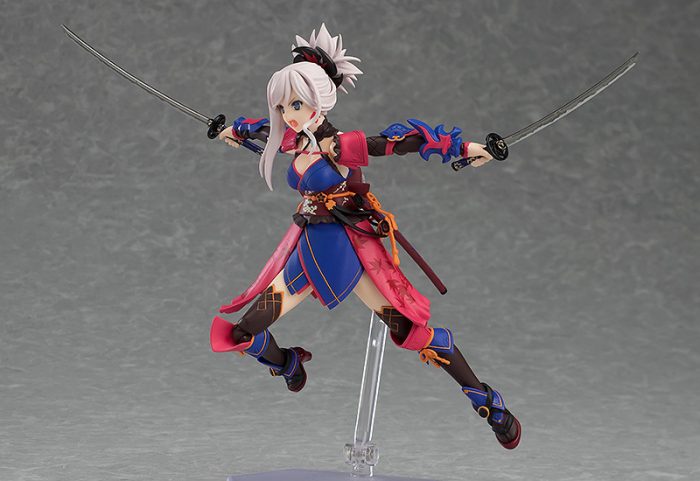
Anime figures are awesome, and the Good Smile Company makes some of the most awesome anime figures there are, mostly in the form of their two flagship brands: Figma and Nendoroids. These massively popular lines have been unrivaled in balancing detail, articulation, number of accessories and affordability all while holding licenses for many of the most beloved manga, anime, and games both new and old.
There’s only one thing that isn’t awesome about these things and that’s the fact that they’re physical. It can be a daunting endeavor to commit to a collection that will take some of what precious little space we have and having two top brands can make it hard to know what products most deserve a spot on your shelf. Lucky for you, we’re here to break down each line’s pros and cons to help you figure out which deserves to win the battle for your shelf space.
Figma
Figma are for when you absolutely need to have the exact character you see on your screen on your shelf. They typically stand somewhere around 150 cm (59 inches) tall and showcase sculpts and paint jobs that are consistently accurate to their source material. In spite of that, just about every one of them can be moved easily and liberally thanks to multiple complex joints that enable extreme articulation without detracting from the figure’s aesthetic. Plus, they come with plenty of alternate limbs, faceplates and other accessories including a stand, granting an incredible amount of freedom in poseability. If there’s a scene from your figure’s source material that you really want to recreate, odds are pretty good that you can do so easily with the right Figma.
Not only can you get a wide variety of poses from these figures, but doing so is incredibly easy as well. A fair number of them can support themselves rather easily and their stands fit with them comfortably and effectively, while their joints all have an easy time staying in place despite their enormous range of motion. Their design lets you turn them into stylish statues, but it also makes it easy for them to act like traditional action figures as well, albeit very expensive ones. They tend to be a bit more expensive than their sister products, but with how much each one can do it’s something that’s hard to complain about.
Nendoroids
For those that like their anime to look more like Isekai Quartet than Shield Hero, Nendoroids are desire personified. They occupy a permanent spot on the top rung of the cuteness ladder without making any significant sacrifices to detail, allowing them to easily adapt original designs that happen to fit their super-deformed aesthetic while turning more complex ones into adorable pocket-sized pals. They almost all stand at roughly 10 cm (4 inches, rounded up slightly) and come with a selection of faceplates, alternate hands, and accessories unique to each figure. Their diminutive size and even smaller limbs come at a cost, though, as while their articulation is still far greater than any toy with their proportions probably should, it’s vastly inferior to the kind of movement you can get from Figma, heavily limiting poseability as a result. Not helping, is the fact that using stands for Nendoroids is way more painful than with Figma. Both models use the same stand design—which supports the figure by fitting a plastic piece into a hole in the doll’s back—without adapting it to account for size differences, though, so it takes very little potential obstruction to make the act of attaching a Nendoroid to its stand a painful experience. If your chibi chum has so much as a belt or even just long hair (which is likely, considering how many characters in the line are female) you can expect using a stand to be the unlockable postgame hard mode version of doing the same thing with Figma. And when you take into account the fact that Nendoroids cannot physically support themselves at all, you’re left with an exercise in frustration.
So, does all this mean that Nendoroids are more limiting than Figma? Of course not! In many ways, they offer way more freedom. Their small size lets you save shelf space while still having a beautiful collection, and makes them the perfect decoration for office cubicles and other spots that can only accommodate smaller decorations. And the fact that Nendoroids rarely have to match their source material gives sculptors worlds more creative freedom than they would have with more accurate figures, which gives the toys an identity all their own.
The Verdict
Okay, so there obviously isn't an actual best out of Good Smile's primary lines of figures and like most things in life, the right choice for you will come down to what meets your individual needs. Do you want sculpts and paint jobs that are nearly identical to your favorite games and anime with articulation to match? Then you should join the Figma family. Do you want a cutesy figure that takes up much less space and don’t mind having to work a bit harder for your best poses? Then it’s time to immigrate to the Nendoroid nation. The most important part of buying figures is always making yourself happy.
Final Thoughts
Whether you came out of this with an interest in Figma, Nendoroids or neither, we hope you enjoyed our look into what makes both unique. Everyone has their own personal criteria for great figures, so let us know which ones have won the battle for your shelf space in the comments and stick around for more on anime, games, figures and everything else.

